To lock or unlock from inside the vehicle
Except for vehicles equipped with the central door lock switch
The rear hatch can be locked or unlocked by using the inside lock knob (driver side).
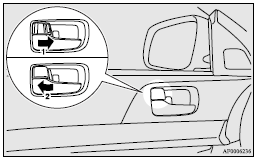
1- Lock
2- Unlock
If the rear hatch is locked or unlocked by using the inside lock knob (driver side), it can still be locked or unlocked with the key.
![]() Note
Note
► Repeated continuous operating between lock and unlock could cause the central door lock’s built-in protection circuit to prevent the system from operating. If this occurs, wait about 1 minute before operating the inside lock knob.
Vehicles equipped with the central door lock switch
The rear hatch can be locked or unlocked by pushing the central door lock switch (driver’s door).
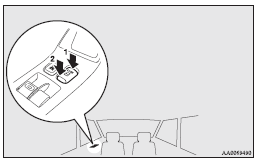
![]() Note
Note
► Repeated continuous operating between lock and unlock could cause the central door lock’s built-in protection circuit to prevent the system from operating. If this occurs, wait approximately 1 minute before operating the central door lock switch.
To open
After unlocking the rear hatch, lift the rear hatch.
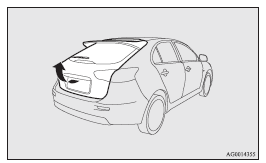
![]() Note
Note
► If you do not open the rear hatch immediately after pressing the rear hatch
OPEN switch, the rear hatch cannot be lifted.
If this happens, press the rear hatch OPEN switch again and lift the rear hatch.
► The rear hatch cannot be opened when the battery is flat or disconnected.
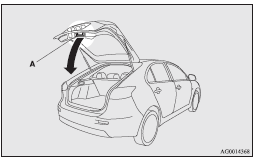
To close
Pull the rear hatch grip (A) downward as illustrated.
Gently slam the rear hatch from the outside so that it is completely closed. Always ensure the rear hatch is securely closed.
![]() Caution
Caution
► When closing the rear hatch, always ensure your or other person’s fingers cannot be caught by the rear hatch.
![]() Note
Note
► Gas struts (B) are installed to support the rear hatch. To prevent damage or
faulty operation.
• Do not hold the gas struts when closing the rear hatch.
• Also, do not push or pull the gas struts.
• Do not attach any plastic material, tape, etc., to the gas struts.
• Do not tie string, etc., around the gas struts.
• Do not hang any object on the gas struts.
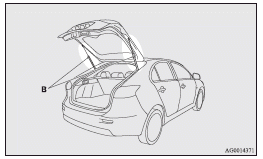
See also:
Headlamps and position lamps
Remove the sealing cover by turning it anticlockwise and disconnect the connector. ...
DPF warning display
The DPF warning display illuminates in the event of an abnormality in the DPF
system. ...
Automatically restarting the engine
Depress the clutch pedal while the gearshift lever is in the “N” (Neutral) position.
The “ ” display/indicator turns off and the engine restarts automatically.
Note
► If the engin ...
